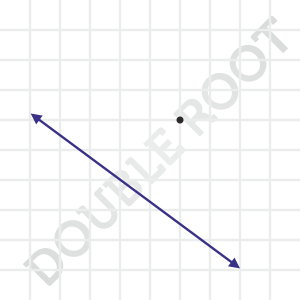This lesson will talk about shortest distance between two curves, the focus being on circles. We’ll subsequently move on to shortest distances between any two curves in later chapters.
Let’s begin with a simple case: the shortest distance between a line and a point.
Shortest Distance between a Point and a Line
Take a look at the figure below.

What will be the shortest distance between this point and the given line?
Let me join the point with some point on the line.

Is this the shortest distance? Can we find a shorter distance? Turns out we can. Have a look.

The shortest distance will be the perpendicular distance between the point and the line, or the distance between the point and the foot of perpendicular from the given point on the line.
The reason is simple – the hypotenuse of a right-angled triangle is always greater than the sides.
That means, if we join the given point to any point other than the foot of perpendicular, we’ll always be able to draw a right-angled triangle. This means we can always find a shorter distance of the given point from the line (which is the perpendicular distance). The following figure might convince you.

Shortest Distance between a Point and a Circle
Now let’s complicate things a bit more. Take a look at the figure below.

What will be the shortest distance between this point and the given circle?
Let me join the point again with some point on the circle.

Is this the shortest distance? I don’t think so. I’m sure you don’t think so too.
Right-angled triangles will help us here too. Have a look.

In the figure above, I’ve joined the point with the centre of the circle, and drawn QR perpendicular to this line. Now PQ will be the hypotenuse of ΔPQR, and thus PR < PQ. Also, we can observe that PS < PR. That means PS is always smaller than the distance PQ, implying that we can always find a smaller distance.
In fact, PS itself is the shortest distance.
And how exactly do we calculate it? Simple – by finding the distance between P and the centre of the circle and subtracting from it the radius of the circle. That is, the shortest distance will be OP – r, where r is the radius of the circle, and O is the centre of the circle.
Will the expression remain the same if the point was inside the circle?
Lesson Summary
- The shortest distance between a point and a line will be the perpendicular distance of the point from the line.
- The shortest distance between a point and a circle will be its distance from the centre of the circle minus the radius.
I’ll stop here. In the next lesson, we’ll talk about shortest distance between a line and a circle, and finally conclude with shortest distance between two circles.
By the way, why do you think am I talking about all this during the discussion of normals? Do you see a normal lurking around?